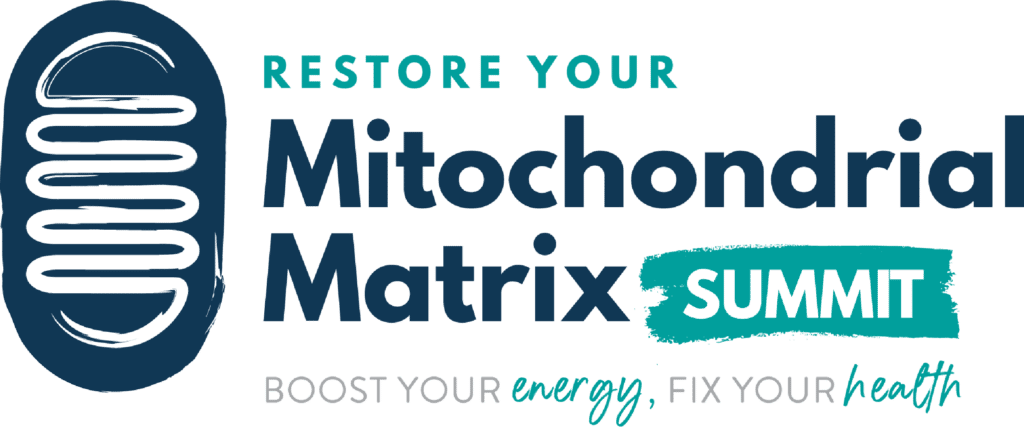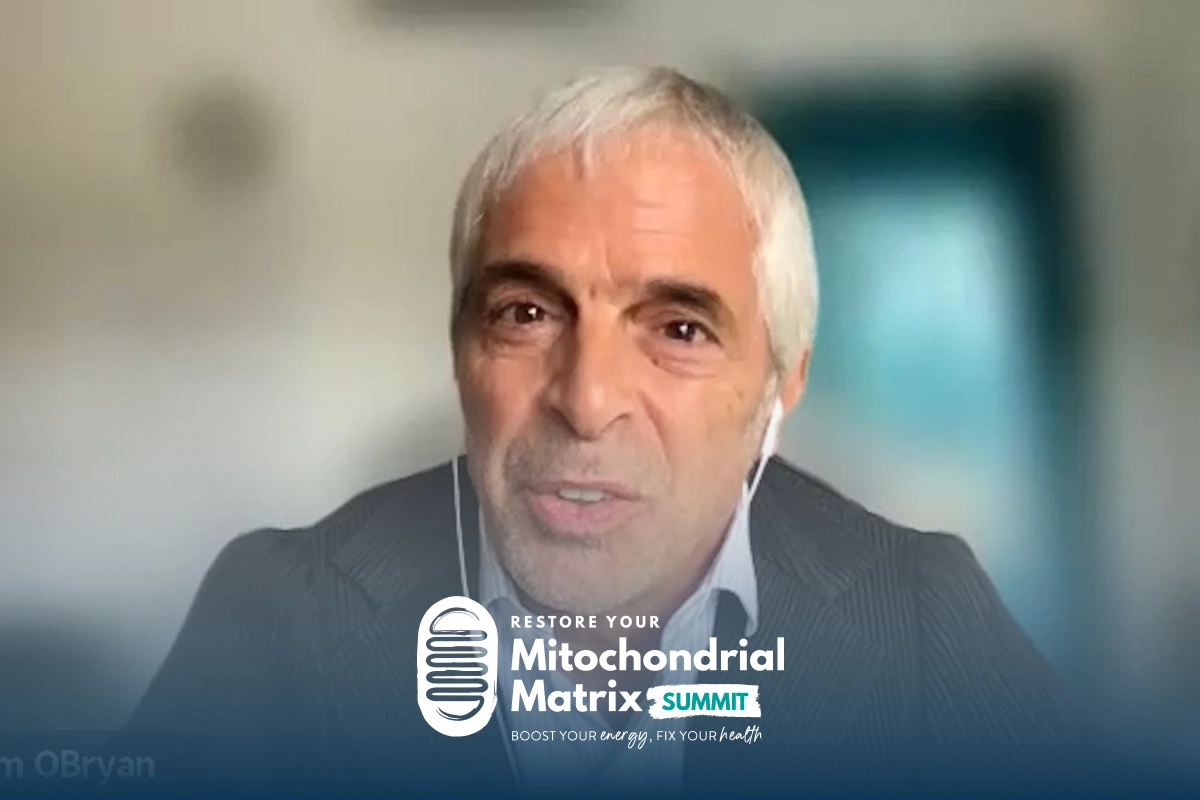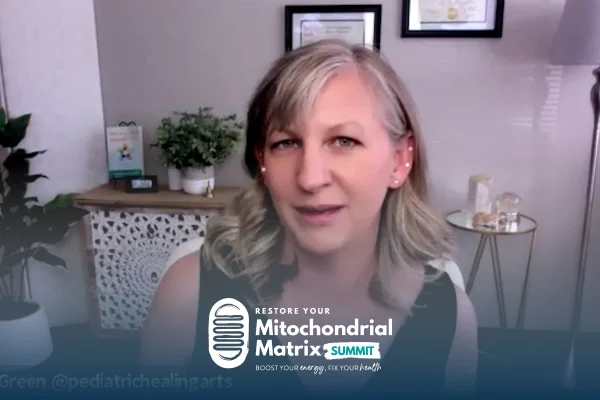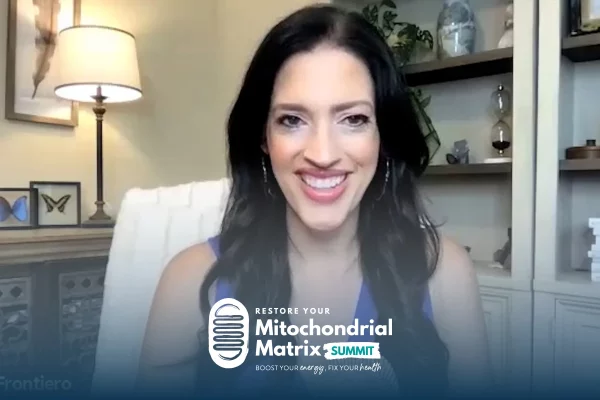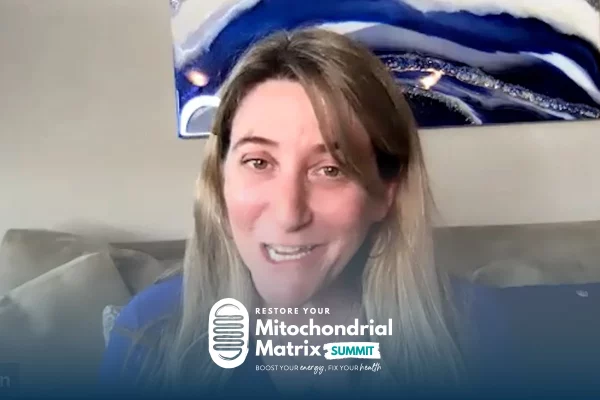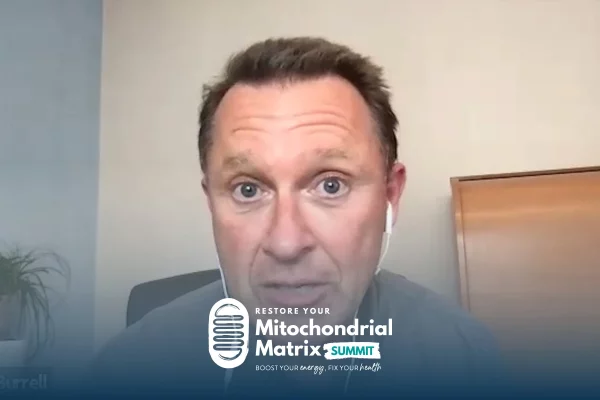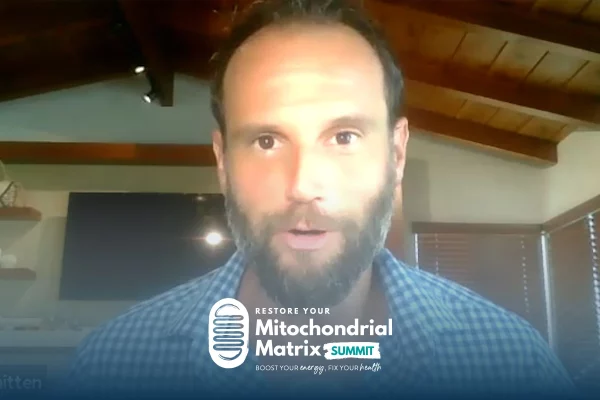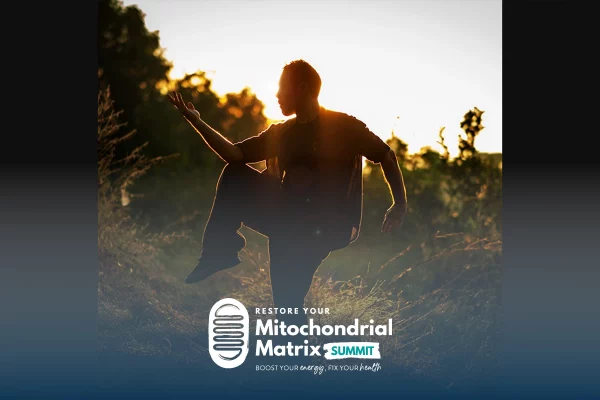Join the discussion below
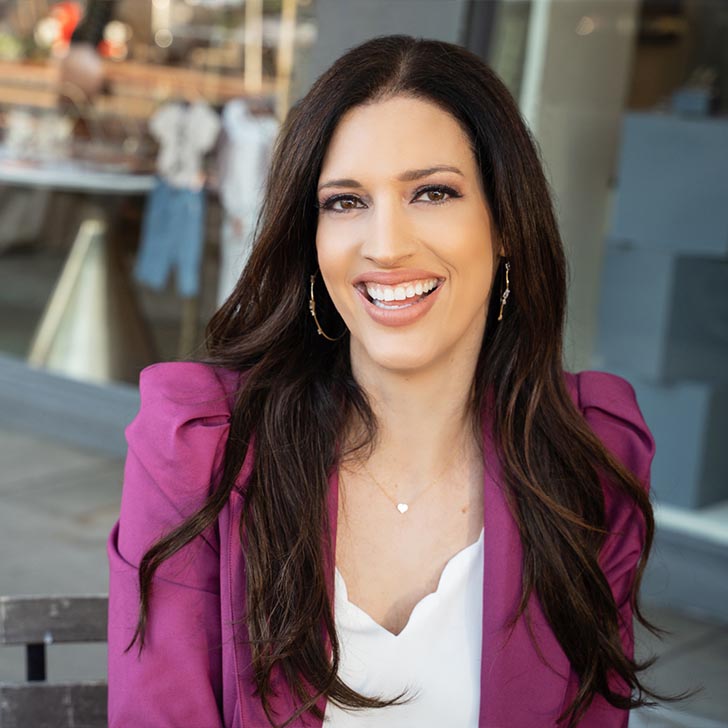
Laura Frontiero, FNP-BC, has served thousands of patients as a Nurse Practitioner over the last 22 years. Her work in the health industry marries both traditional and functional medicine. Laura’s wellness programs help her high-performing clients boost energy, renew mental focus, feel great in their bodies, and be productive again.... Read More

Tom O’Bryan, DC, CCN, DABCN, CIFM
Dr. O’Bryan is considered a ‘Sherlock Holmes’ for chronic disease and teaches that recognizing and addressing the underlying mechanisms that activate an immune response is the map to the highway toward better health. He holds teaching Faculty positions with the Institute for Functional Medicine and the National University of Health... Read More
- Mitochondria are Team Players-they’re not solo Superstars
- How to enhance mitochondrial function in a toxic environment
- The role of detoxification in restoring your energy
Related Topics
Autoimmune Disease, Autoimmunity, Biological Function, Biomarkers, Brain Function, Butcher, Cell Function, Chronic Disease, Development Of Autoimmune Diseases, Energy Production, Engine Of The Body, Engine Overheating, Environmental Toxins, Farmers Markets, Food Sensitivities, Fueling The Furnace, Functional Medicine, Gluten, Health Complaint, Impact Of Wheat Sensitivity, Individual Autoimmune Diseases, Mitochondria, Mitochondrial Function, Mitochondrial Health, Nutrition, Organ Meat, Organic Meats, Red Zone, Teaching Faculty Positions, Temperature Gauge, Thyroid Function, Toxins, Wheat SensitivityLaura Frontiero, FNP-BC
Welcome to another episode of the Restore Your Mitochondrial Matrix Summit . I’m your host, Laura Frontiero. I’m bringing you experts to help you boost your energy and fix your health so you can build the life you love. And today I have such a special guest for all of you. It’s Dr. Tom O’Bryan. Hi, Tom. Welcome to the summit.
Tom O’Bryan DC, CCN, DACBN, CIFM
Thank you so much. It’s a pleasure to be with you. Thank you.
Laura Frontiero, FNP-BC
Yes, so much. Well, I think most people watching probably know who you are, but let me introduce you just a little bit in case we have some newbies with us. So Dr. Tom, you’re an expert on food sensitivities, environmental toxins, and the development of autoimmune diseases. That’s really a big one. You’ve written a lot of books about this. You’re considered a Sherlock Holmes for chronic disease. And not only that, you hold teaching faculty positions with the Institute of Functional Medicine and the National University of Health Sciences. You’ve trained and certified tens of thousands of practitioners around the world, understanding the impact of wheat sensitivity and the development of individual autoimmune diseases. So thank you so much for being here today. We’re gonna tap into your brain and your expertise on mitochondria. We were just having a little pre-talk before we started recording about the importance of mitochondria in pretty much healing up any chronic health condition that you have. So welcome. Thank you so much for being here.
Tom O’Bryan DC, CCN, DACBN, CIFM
Thank you. Thank you. It’s real pleasure. And this is a critically important topic.
Laura Frontiero, FNP-BC
It is. It is. Now, I know that you come on summits a lot to talk about autoimmunity and wheat and gluten and all of that. And we can touch into all of that, but would you connect the dots right now for the audience on mitochondria and why this is important to get healthy? And if you have symptoms and you’re trying to figure this out, why is this such a critical part of the big picture?
Tom O’Bryan DC, CCN, DACBN, CIFM
When I moved to California in 2010 from Chicago, I was really happy. You know, I played Led Zeppelin all the way going to California. I hear it repeat on that and just got pulled over a couple of times. I was going a little too fast on the freeways. And the troopers were kind enough to… I’m sorry, man. I’m moving to California, I’m going to California and I got lost in the music. Nice guys. But I had a really enjoyable time traveling for three days across the country, taking my time. And I had a nice car. You know, I drove an Acura SUV. It was a comfortable car. You aren’t going anywhere. If you wanna go from one place to another place, if you wanna go from dragging thyroid problems, I can’t think very well, and you wanna get to really good brain function, adequate thyroid function so that your energy’s up there, you aren’t going from here to there.
Unless you got a good engine in your car, you aren’t gonna get anywhere, right? I couldn’t walk to California. I needed a good car to get there. Mitochondria are the engines in every cell of your body. So for your cells to work better. I mean, obviously, if you’ve got a health complaint, something’s not working very well. And if you want it to work better, you’ve gotta have enough energy and you have to point in the right direction. You gotta steer where you’re going, meaning the foods you eat and the supplements, or, if necessary, the medications. You have to steer in the direction of what you want, but you gotta have enough juice in the engine to go. That’s your mitochondria. That’s the bottom line, as far as I can tell, about mitochondria.
Laura Frontiero, FNP-BC
I love this analogy. It’s so much better when we speak in analogies. I remember biology class and it was really fun to dissect stuff. And once we got to the Krebs cycle, my brain shut off and that gets ready-
Tom O’Bryan DC, CCN, DACBN, CIFM
Yes.
Laura Frontiero, FNP-BC
At abort. But if the biology teacher just could have spoke about it in these kind of easy-to-understand terms. So what I’m hearing you say is this is a really important part of the big picture.
Tom O’Bryan DC, CCN, DACBN, CIFM
Yeah, it is. It’s a critical part. Critical. It’s not the whole picture, but it’s a critical part of the picture. I’ll give you an example. You know, we eat meat in our family on occasion. Maybe once a week or so red meat. And so I found an organic rancher here, very proud of how he raises his cattle and shows me pictures of the grass and what type of grass it is they plant for the cattle and all that. And when he’s going to harvest an animal, I buy the heart of the animal, and then I ask him to weigh it, and then I want the same weight of ground meat of the animal. And I want him to grind it together, and then put it in one pound packages for us. And I buy like 30 packages at a time, something. 20, 30 packages. Well, why would I do that? ‘Cause I don’t like the taste of liver very much or kidney or any of that.
But heart, when you mix it with ground meat, it is delicious. It tastes like the highest quality hamburger or taco meat or meatloaf. Like, wow, that’s really good. It doesn’t have any distinctive weird flavor to it. And the heart is the portion of meat that has the highest concentration of mitochondria of any tissue in the body. And so when you eat protein, and if you’re eating meats, I wanna include high concentrations of mitochondria ’cause we have a young boy now, and I wanna make sure we’re giving him the most potent food that we can that’s safe and healthy for him. So I’m thinking about my mitochondria in the food that I eat and of course in the supplements that I take. It’s a component that you always want to keep in mind is fueling the furnace. You wanna make sure that you’re putting enough fuel in the furnace so that it can function for you the way you want it to.
Laura Frontiero, FNP-BC
Thank you for breaking that down and making it so simple. So it’s really important. Not only are we eating organic produce, it’s important what kind of animal we’re eating as well, if we are meat eaters. And I’m with you. I don’t love the taste of liver either. So this is a brilliant idea. Now those of us listening and viewing have to figure out, how do I get in touch with a butcher and get my own portion of the cow? It is possible. I bet in your area somewhere you can find this same scenario.
Tom O’Bryan DC, CCN, DACBN, CIFM
Yeah. You bet.
Laura Frontiero, FNP-BC
Just go to the farmers’ markets. Look for someone that’s got organic meats. Or, ask the local organic farmers, “Hey, is there a rancher around that’s organic and avoids antibiotics and all of that?” And it may take a little bit of footwork, but you’ll find them.
Tom O’Bryan DC, CCN, DACBN, CIFM
Yep. And you can go in with another family or friends on buying the animal, and everybody gets a coffin freezer in their garage and there you go.
Laura Frontiero, FNP-BC
That’s right. That’s exactly right. That’s a smart way of doing it for a family.
Tom O’Bryan DC, CCN, DACBN, CIFM
Yeah.
Laura Frontiero, FNP-BC
Very smart.
Tom O’Bryan DC, CCN, DACBN, CIFM
Probably saves a lot of money as well at the end of the day.
Laura Frontiero, FNP-BC
It does.
Tom O’Bryan DC, CCN, DACBN, CIFM
Yeah.
Laura Frontiero, FNP-BC
It does. So when we’re thinking about mitochondrial function, tell us about the big kahuna. What is that, and why do we have to keep that in mind? That’s one of your terms, big kahuna.
Tom O’Bryan DC, CCN, DACBN, CIFM
Yes. If you are watching this summit, it likely means there’s some aspect of your body function that you’d like to see function better. Maybe it’s your brain. Maybe it’s your gut. Maybe it’s your energy. Maybe it’s your thyroid. But you want your body to function better and you’re learning that the furnaces in the cells of that tissue are a critically important component. And they’re a biomarker. And what’s that? Well, it’s a geek term. You know, it’s a good Scrabble word. But it’s a geek term. And what it means is the gauges on the dashboard. We had a 1986 Chrysler minivan and we were coming back from summer vacation. We lived in Chicago at the time. And there was a 90-90 day. 90 degrees temperature and 90% humidity. One of those hot, humid, August days in the Midwest. So I had the air conditioning on, the kids in the back seat playing a game, listening to some soft music, driving 70 down the highway, just cruising, having a good time, but my temperature gauge on the dashboard started moving.
Now, there’s two ways to measure the temperature in the engine of a car. Some cars have a hot light that comes on, says, “You’re overheating, you’re overheating, you’re overheating.” And you gotta pull over really quick or you’re gonna blow up the engine. Other cars have a temperature gauge. And you can see the temperature gauge climbing towards the red zone. So I’m watching this thing as we’re going down the highway and it’s moving every little bit. I’m hoping it’s gonna stop where it is. And it moves a little bit more and oh no. Finally, I say, “Oh no. My wife said, “What’s wrong?” I said, “The temperature gauge is going into the red zone.” The engine’s about to overheat. Oh my gosh. I said, “No, we’re okay, we’re okay.” So what did I do? I turned off the air conditioning to take a load off for the engine, rolled down the windows ’cause it got really hot without the air conditioning. So now we’ve got the wind coming in and it’s loud and all of that, and turned off the music, and we made it home.
We didn’t get stuck in Gary, Indiana because I observed the biomarker before it was too late, you’re overheating, the engine’s gonna blow up if you don’t pull over really quick. So what’s the big kahuna when you’ve got a health condition, that something’s not working the way you want it to? It doesn’t matter what it is. The concept is the same. The National Institute of Health just revised their statistics. It used to be 8 out of 10. Now it’s 14 out of 15 of the top causes of death in the US, meaning what’s very likely to take you down at some point. What’s very likely to take you down, 14 of the 15 top causes, are chronic inflammatory diseases. It means that you’re on fire. There’s excessive inflammation in your body going on. And we know that goes on for years where you feel fine until you don’t quite feel so good anymore. And things just on occasion aren’t great, and then it’s more often, more often.
Now it’s constant. And now you get diagnosed with something. It’s inflammation. So mitochondriopathy, a dysfunction of the mitochondria, is the result of a chronic inflammatory condition in your body. You don’t take a pill to fix the mitochondria. You have to stop or reduce the inflammation. Now, inflammation is not bad for you. Excessive inflammation is bad for you. That the immune system is designed to protect us. It’s the armed forces in your body. It’s the Army, the Navy, the Air Force, the Marines, the Coast Guard. We call ’em IgA, IgG, IgE, IgM. You know, there’s really technical terms, but it’s just the armed forces. So it’s there to protect you. So the question is, when it’s activated and there’s excessive inflammation going on, the question is, what’s it trying to protect you from? And you have to put some time into learning what it is about your current lifestyle. Not intentionally. You think you’re doing good, but, well, here’s the result. Something’s not working very well right now. You think you’re doing good, but something’s stopping you. Something’s not functioning properly, which means chronic inflammation has been going on for quite a while.
Laura Frontiero, FNP-BC
So this is a big one. I’m so glad you’re bringing up inflammation. This is the big kahuna. It’s the big underlying reason that so many people can’t heal. It’s the reason, as you’ve mentioned, taking CoQ10 isn’t gonna solve the problem because you’re not solving the inflammation problem. So can you go into a little bit what’s causing the inflammation? What are the hallmark symptoms of inflammation? How would somebody know that they have it? What are they looking for?
Tom O’Bryan DC, CCN, DACBN, CIFM
If 14 of the 15 top causes of death are chronic inflammatory diseases, the only one that’s not as unintentional, injuries. You get in an accident. You know, aside from that, every other condition is a chronic inflammatory condition. What that means is when you don’t function well, when you don’t feel well, when something’s not working the way you want it to, it’s a chronic inflammatory condition. It’s pretty safe to just assume that across the board. And we know that these autoimmune conditions like MS and rheumatoid, scleroderma, Sjogren’s, alopecia, losing your hair, psoriasis, eczema, Alzheimer’s, Parkinson’s, these autoimmune conditions go on for decades. There’s biomarkers, temperature gauges, that you can identify that are out of balance years and years and years before you get a symptom.
This is the world of what’s called predictive autoimmunity. That you can do a simple blood test and you can identify, wow, my brain’s on fire. Wow, it’s really on fire right now. Well, I feel fine. And although, yeah, I forgot where I parked my car in the parking lot yesterday. Yeah, I did. Yeah, my keys. Every once in a while I’m looking for my… You start to realize, “Wow, my brain’s not quite as sharp as it used to be. There have been these incidents going on.” And you do a simple blood test and you see that you’ve got 18 different markers of inflammation in your brain, it’s gonna freak you out. And it’s supposed to. It’s supposed to scare the crap out of you because what it means is the way you’ve been living your life somehow is creating this inflammation. And the problem with inflammation is that you’re killing off brain cells, killing off brain cells, killing off brain cells. And you can’t feel when that’s happening. You can’t feel it.
Laura Frontiero, FNP-BC
So sorry. You can’t feel it and you can detect it with a blood test.
Tom O’Bryan DC, CCN, DACBN, CIFM
Yes.
Laura Frontiero, FNP-BC
So if somebody doesn’t have a practitioner who knows which test to order, how to get them, what do they do?
Tom O’Bryan DC, CCN, DACBN, CIFM
Well, two things. If you take the time, you can read my book, “You Can Fix Your Brain.” I mean, I went around with Rodale Press for two weeks on the title. They had all these different titles. No, no, no, “You Can Fix Your Brain.” You know, it’s that simple. And so if you take the time to read the book, it all makes sense. It all does. And it’s also audio, if you like to listen while you’re walking or exercising or something. But once you get educated enough to understand what questions to ask, you can order the tests on my website. I make it available to the general public. I always recommend you download the information and take it to your doctor and let them order the test so that they start to learn about this. But it’s a major undertaking to learn about a test that looks at 53 different markers of inflammation in your brain. It’s gonna take them six months to really dial down a complete understanding of the test. And here’s an example.
And it’s the kind of thing, Laura, that you’re well familiar with. Two decades ago, we were talking about AGEs. Advanced glycation end products. That when you burn meat, like on a barbecue, or you burn dough, like bread, and it rises and you get this hard crust, advanced glycation end products, that they accelerate the aging process if you get too many of them. I mean, we learned that as nutritionists a long time ago. Turns out that one of the markers of inflammation in the brain is when you’re making antibodies to the receptor for advanced glycation end products, because those receptors sit on the brain tissue. So if you’re making antibodies to the receptor, they’re called RAGE, receptor for advanced glycation end products. So If you’re making antibodies to RAGE, that is a powerful contributor to inflammation in your brain, killing off brain cells, killing off brain cells, killing off brain cells. What do you do?
Well, we all know, if we’re nutritionally based, that with high levels of advanced glycation end products, how do you turn that around? You eat more fresh fruits and vegetables that are just softly cooked. And you increase the percentages in your diet. Right now, if your diet is 20% vegetables, I’m making it up, and mostly pasta and meat, well, it’s gonna be 60%. And you may transition over the course of a month or two, but you’re consciously working on finding ways that you enjoy having vegetables at breakfast, or fruit and vegetables at breakfast and at lunch and at dinner. And you make it a part of your life. And you look for the recipes and how to do that. And there’s lots of sources out there for that kind of thing. But when you’ve got elevated antibodies to RAGE, you’ve got too many advanced glycation end products causing inflammation in your brain. And so there’s things to do for each of the markers of, the test is called the Neural Zoomer Plus ’cause you zoom in on the problem. The Neural Zoomer Plus. It’s remarkable. I think everyone will benefit from doing a test like that because you see how much inflammation is there in your brain right now.
Laura Frontiero, FNP-BC
I’m so glad you’re bringing this up ’cause I think most people are not aware of this test. And, like you said, you can get it straight from your website. I’m familiar with the lab that offers this test as well. And they’ve got some wonderful technology of zooming in and looking. Several consumers-
Tom O’Bryan DC, CCN, DACBN, CIFM
You know, Mayo Clinic has published five papers that I’ve got, and there may be more, but I’ve got five of them, on the exceptional accuracy of this technology. They don’t do that for laboratories. You know, you can’t buy off Mayo Clinic to write a nice report on your technology. You can’t do it. But they’ve written five papers in the last, since 2016, with this current viral epidemic, the test for that, and others say, “Wow, this technology is the best we’ve ever seen. We get very accurate answers when you do these tests.” So every person that talks to me, what do I do? I don’t care what their symptoms are. They’re gonna do the Wheat Zoomer and the Neural Zoomer Plus. Those two tests to begin with ’cause they’re excellent markers of inflammation in the brain. Now, how important is it to focus on the brain?
Blue Cross Blue Shield came out with a study two years ago, and they said that in four years, between 2013 and 2017, in that four-year period, there was a 407% increase in the diagnosis of Alzheimer’s in 30 to 44-year olds. 407% in 30 to 44-year-olds in four years. We have a huge problem in our culture right now that is burning out our mitochondria. And the primary source of the problem is the amount of chemicals that we’re all exposed to every single day and that have gotten stored in our body. They’re called endotoxins. That means toxins that are inside your body. Exotoxins are toxins outside your body. Once again, good Scrabble words. But endotoxin is what’s already inside. If you have silver fillings, the mercury silver fillings, that’s an endotoxin ’cause it leaches a little mercury every time you chew, just a little bit. Not a dangerous amount, but it accumulates.
Laura Frontiero, FNP-BC
So I’m really glad you brought up toxins. We’re doing a lot of talking about toxins. And of course I wanted to pick into your brain about this because it took me a while to figure this out. The journey of learning integrative and functional medicine is a big one when you come from a Western medicine background. And so in the beginning, I thought, “Okay, I’m gonna help people clean up their gut microbiome. I’m gonna help people support their mitochondria. I know all this information about mitochondria and what cofactors and supplements to give.” And then I realized after that, oh, I’m not getting anywhere with people unless we’re dealing with toxins. So that is like a block for success. When people have seen multiple practitioners, they tried everything, and they still aren’t well, the question is, have toxins been addressed? So speak about that and what kinds of toxins we’re looking at in the body, what we need to do about it, how we get rid of them.
Tom O’Bryan DC, CCN, DACBN, CIFM
Critically, critically important topic. Arguably the number one topic for most degenerative diseases today. Never in history have humans been exposed to the amount of toxins that we’re exposed to. We even know that from our friend, Dr. Dale Bredesen, and he wrote the book, “The End of Alzheimer’s,” we know that 60 to 65% of all Alzheimer’s is called inhalation Alzheimer’s. It’s what you’re breathing. You don’t realize that your sofa is outgassing flame retardant chemicals into the air because you can’t smell it, you can’t see it. But it is. Or the plastic blinds on your windows are out gassing phthalates, plasticizer chemicals into the air. But they do. Or that the plastic containers you use to store leftover food. The next day, the food has got those phthalates, those chemicals like BPA, in the chicken, and then you eat the chicken.
Now, there’s no evidence that the amount of chemicals that outgas out of your sofa, out of your down comforter, if it’s not organic, out of your sleeping gear, if it’s not organic cotton, that the flame retardant chemicals in those products that are outgassing and you’re breathing them in, can’t smell ’em, but there’s no evidence that the amount of flame retardant chemical that you breathe in from that sofa or from that down comforter is toxic to humans. There is no evidence of that. And that’s how they get away with this, is that they paid off the senators and the representatives to pass the legislation called the Toxic Substance Control Act, which regulates all new chemicals introduced into the environment, and you have to prove that the amount of chemical that you’re exposed to is toxic to humans. It is not, but they accumulate in your body. These chemicals accumulate. You don’t get more fat cells after the age of two or three.
They just get bigger and smaller. Well, what are they getting bigger with? These toxic chemicals that the brain says, “Get this off the highway. Get this stuff out of the bloodstream. Get it out of here.” And so it gets thrown into storage. And so they accumulate over the years. Now, give me a little girl, five years old, she starts painting her 10 little fingers and 10 little toes once a week with nail polish. And the phthalates, the plasticizers that harden the Polish, they are in your bloodstream in four to five minutes after you apply ’em on your nails, but there’s no evidence that the amount of phthalates that leach into your bloodstream is toxic to humans. But gave me a little girl that does that for 20 years, now she’s 25 to 30 years old, married, wanna have her first child, and hopefully she has a healthy pregnancy and a healthy delivery, but let’s take a look. Chicago, 2016. 346 women in the eighth month of pregnancy, they measured the number of phthalates in their urine. That’s the plasticizing chemicals.
And they divided it into fourths, the women with the lowest amount, the next, the third, and the highest amount. Then they followed the offspring of those pregnancies after the children were born. And when the children turned seven years old, they did Wechsler IQ tests on them. The official IQ test. Now, there’s not much in medicine that’s all or every, but this was every. Every child whose mother was in the highest category of phthalates in urine in pregnancy, compared to the children born of the mothers in the lowest quartile of phthalates in urine in pregnancy, every child in the highest quartile, their IQ was seven points lower than these kids. Seven points. Now, that doesn’t mean anything to anybody here, until you understand that a one point difference in IQ is noticeable. A seven-point difference is a difference between a child working really hard getting straight A’s and a child working really hard getting straight C’s.
This child doesn’t have a chance in hell of ever excelling in school. Why? Now just Google phthalates, P-H-T-H-A-L-A-T-E-S, phthalates and neurogenesis, nerve growth. Here come the studies that the phthalates inhibit your brain and nerve growth. So mom, who started nail polish when she was five years old and eating out of Tupperware containers and getting all the plasticizers in the air that accumulate in her body for 20, 25 years so her urine was in the highest amount of phthalates in urine. And with her current diet ’cause she stores food in plastic wrap and whatever other, there are many contributors, but she doesn’t know. She thinks she’s living a healthy life. Now she has a baby and that baby’s brain never develops properly in utero. That’s the kind of stuff we’re up against. I’m gonna give you one more study, and then I’ll pause. This was in the journal of the American Medical Association. And the editors of the journal wrote a comment saying, “This is an elegant study with sophisticated biomarkers.” And as you know, Laura, you don’t see the editors of the journal of the American Medical Association giving out stamps of approval like that.
That is extremely rare that that happens. So what’s the study? They looked at couples at assisted fertility centers. And they divided them into two groups. They found the couples that were eating completely organic, and they found the couples that were not eating organic. Regular, conventional fruits and vegetables. Once again, they put them into fours. The lowest amount of fruits and vegetables, the second, the third, and the highest amount of fruits and vegetables. And then they compared the two groups of highest amount of fruits and vegetables, those that were eating conventional, bought at the local supermarket, and those that were eating organic. If you were eating conventional vegetables, you had an 18% less likelihood of successful pregnancy, of getting pregnant. 18% less likely, which is huge.
And these people are spending tens of thousands of dollars. But this was the kicker. If you got pregnant, you had, and eating conventional fruits and vegetables at the highest amount, living a healthy lifestyle, conventional fruits and vegetables, you had a 26% less likelihood of a live birth. The miscarriages and stillbirths, 26% more than the couples eating organic. That’s murder. Excuse me, but that’s just unacceptable by any standard. And any healthcare professional says, “Well, that’s too bad. Yeah, you really should eat organic, Mrs. Patient.” And then you walk away making a lame comment like that. Shame on you. That you’re the ones that, but these aren’t healthcare practitioners. These are the general public. But this is how I am on stage. You know, I’m going to Dublin in 10 days for a couple of talks, and then in London for four talks. And this is how I am. It’s like, shame on you. Get these studies, read the studies, and never again say, “Well, you really should eat organic,” and then forget about it. Sometimes you have to give this terrifying data to people to move them off the fence.
Laura Frontiero, FNP-BC
And I’m so glad you’re bringing this to light. I can tell the passion with which you are speaking. I mean, let’s face it, Tom, you’ve had a full career. You don’t need to be doing this anymore. And here you are still traveling the world teaching, still coming on summits and teaching, because somebody has to carry the torch for this. Somebody has to empower people to speak the truth of what’s happening. And toxins are destroying our longevity. They’re creating illness in our young populations. The life expectancy is going down. The difficulty getting pregnant is going up. I mean, this is a huge problem. And I know we’re on a mitochondria summit, but it’s all related. It’s all related.
Tom O’Bryan DC, CCN, DACBN, CIFM
It’s all related.
Laura Frontiero, FNP-BC
So basically with what you just said is we’re all being exposed all the time. And so whether you do a test or not to measure your inflammation, you better do something to reduce your toxic exposures because that’s contributing to inflammation. So let’s take this time we have left to help people really see what can they do right now to start lowering this. I mean, what comes to mind for me right now is get an air purifier. I mean, I feel like we’re in the era of everybody wants everything to look new and bright and shiny and they want it right now. And so now furniture is very accessible, very inexpensive, cheap. You can have new stuff delivered today by the end of the day. And it’s just a big toxic load that you’re putting into your home, right.
Tom O’Bryan DC, CCN, DACBN, CIFM
Exactly right.
Laura Frontiero, FNP-BC
All right, so let’s start there. Get an air purifier. I mean, what’s a good air purifier? How much do people gotta spend? And what kind of benefit could this create?
Tom O’Bryan DC, CCN, DACBN, CIFM
There was a consumer reports type of review of the top 10 air purifiers. And the one that came out on top is the AirDoctor.
Laura Frontiero, FNP-BC
Amazing.
Tom O’Bryan DC, CCN, DACBN, CIFM
And so that’s on my website. And you can find them anywhere, but there’s a discount on my website for the AirDoctor. But this is even easier if you can’t afford to get one. NASA realized that their astronauts were acting like bozos in space at times, and they really couldn’t figure what’s wrong. Why are you saying that? That type of thing that the public never hears went on a lot. And they realized that the air was full of these phthalate chemicals and other toxins in the air. So they did a bunch of studies on house plants and the effect of house plants in the air. And they showed, and you go to my website, thedr.com/plant, and there’s the handout for you, they showed that two six-inch house plants in a 10-by-10 room absorbs over 70% of the toxins in the air. It’s a no-brainer.
And so if you’ve got eight rooms in your house, you go buy 20 house plants. Little six-inch house plants. And some people have said, “Well, I don’t have a green thumb. They’re gonna die.” Then you buy more. But in the meantime, your children’s bedroom has a couple of house plants that are gonna absorb toxins and, at night, put more oxygen into the air.” So you clean the air with house plants. That’s simple, inexpensive. And they’re the everyday house plants like mother-in-law’s tongue and English ivy. And so they just identified a bunch of plants that are easy to get, inexpensive, like you’ve got behind you, over your left shoulder. You know, you just want a little house plant in the room. That’s larger than a six-inch house plant, but that’s gonna do the job.
Laura Frontiero, FNP-BC
Amazing. And in front of me are more house plants. And those snake plants are so popular right now. They’re the ones that are kind of long and tall and everybody has them and decorating with them. So there you go, quick and easy and cheap and fun. And take a field trip to Home Depot and have the family pick out house plants. Easy. Okay.
Tom O’Bryan DC, CCN, DACBN, CIFM
There you go.
Laura Frontiero, FNP-BC
What else do you got to start lowering this toxic load? I mean, our food comes wrapped in cellophane at the store, packaging. I mean, what do we do? How do we get away from this?
Tom O’Bryan DC, CCN, DACBN, CIFM
First, we have to understand that this is a learning curve. It’s gonna take a while to dial it down. The subtitle of my book, “You Can Fix Your Brain,” is really the answer. The subtitle is just one hour a week to the best memory, productivity, and sleep you’ve ever had. And it’s not a cutey subtitle. I had to argue with them to put it on there. It’s the path to success because we’re all so busy. But you tell your family every Tuesday night after dinner, or every Sunday after service, whenever it is, but every week, “Don’t bother me for the next hour because I’m going to learn more how we can be healthy.” And then you go to my book and you look for the three URLs for glass storage containers in the kitchen. And there’s Miles Kimball and there’s Amazon. I don’t remember the third one. And you go on there and you say, “Oh, those are nice. Oh, I really like those.” And you order three round ones and two square ones and one for the pie. And you pay for the credit card, you hit sent, you’re done. It took an hour, but you’re done for the week.
Next week, you download the article on house plants and you then go to Home Depot and you buy the house plants. That takes more than an hour, but you understand the concept. Next week, you look online for organic cotton sheets for your beds, for you and your children. And you look around and you find, you order ’em. Next week, you do the next thing. You get the, it comes from bees and I forget what it’s called, but instead of plastic wrap on your food, you use this kind of paper, this beeswax paper that’s non-toxic. And that’s in your kitchen now. Next week. And you do that one hour a week. And in six months, you’ve dialed this down. You’ve got it. It’s not simple. It’s not easy. It’s overwhelming, so you take little bite-sized pieces, but you stay focused on it every week, one hour. And the result is, in six months, you’ve dialed this in. You have a much less toxic home environment for you and your family.
Laura Frontiero, FNP-BC
Amazing. That is the sure way to fail, is to try to change everything all at once. Not only will you give up, you’ll totally piss off your family. They’ll think you’re crazy if you’re throwing out their favorite stuff and getting rid of their favorite things and switching out all their body products and everything in one weekend. You’re gonna make enemies. So make it a fun thing for everyone. Get everyone involved. Hey, this week we’re gonna switch out sippy cups and what we eat dinner off of or what we cook with. Come on, help me pick something out.
Tom O’Bryan DC, CCN, DACBN, CIFM
Right, exactly. Exactly. And we did that for sippy cups, and we bought silicone because the stuff doesn’t leak. And so our son eats a, and we have a little roll-up one that we take with us when we go to a restaurant. We lay on the table in front of him. We put the food on that. And so he’s comfortable with that. My wife, our son has loved scrambled eggs. But lately, he’s not so much into scrambled eggs, anyway. He doesn’t want to eat ’em. So she started thinking about it and she went online, she looked for a couple of recipes, and she made egg cupcakes today with a little bit of potato in it, a little bit of spicing, and he just ate four of ’em. It’s like, he ate more than I did. You know, so when you take the time to learn something new in bite-sized pieces, you build your path to success.
Laura Frontiero, FNP-BC
Yes, this is the key. This is the key. These are really great. I think it’s giving people hope. I mean, we are gonna be exposed to toxins. This is what’s happening right now. I mean, we’re in the plastic age, right? Anthropologists say, 1,000 years from now, they’ll look back and they’ll see the plastic age, the plastic in our environment. And also what I’m hearing from you is it’s not just enough to have BPA-free plastic. Get rid of the plastic.
Tom O’Bryan DC, CCN, DACBN, CIFM
Oh my God, yeah. They use BPS now. And people don’t know yet, but BPS is more toxic than BPA.
Laura Frontiero, FNP-BC
Right, so BPA-free has become an advertising gimmick by manufacturers to say, “This is safe, it’s BPA-free.” But that’s discounting all the other chemicals that are in there. So use glass, use stainless steel, use silicone, use cast iron-
Tom O’Bryan DC, CCN, DACBN, CIFM
Ceramic. Yeah, yeah.
Laura Frontiero, FNP-BC
Ceramic. I mean, thinking about cookware, everything.
Tom O’Bryan DC, CCN, DACBN, CIFM
Yeah, what’s the name of that French company? Le Creuset?
Laura Frontiero, FNP-BC
Le Creuset.
Tom O’Bryan DC, CCN, DACBN, CIFM
Oh, every woman smiles when they talk about. Yeah, exactly.
Laura Frontiero, FNP-BC
Yes.
Tom O’Bryan DC, CCN, DACBN, CIFM
You start learning what safer, non-toxic tools are to have in your home.
Laura Frontiero, FNP-BC
And Le Creuset is fun ’cause it comes in every color under the rainbow, and you can mix and match and have a good time with it. And you know what-
Tom O’Bryan DC, CCN, DACBN, CIFM
There you go.
Laura Frontiero, FNP-BC
you can buy it at the outlets, and you can buy it used. We have vintage Le Creuset that was from, I think, the 1960s. And so you can find some fun stuff as well. So make it fun to go find.
Tom O’Bryan DC, CCN, DACBN, CIFM
Yeah. So here’s the woman who walks with pride that she’s got vintage Le Creuset.
Laura Frontiero, FNP-BC
I do.
Tom O’Bryan DC, CCN, DACBN, CIFM
That’s fabulous. Fabulous.
Laura Frontiero, FNP-BC
I know, I know. Okay. So I mean, we could talk all day, but any other tips for decreasing toxins so that people can recover their health, reduce inflammation, heal their mitochondria, get rid of these chronic health conditions? I mean.
Tom O’Bryan DC, CCN, DACBN, CIFM
You nailed it on the head, the first one. The most important one is the air you’re breathing. And indoor air pollution is much worse than outdoor air pollution because of all of the things in your home that are outgassing. And you just don’t know this. So when my daughter bought a new home, for them, it had been completely gutted and remodeled. Originally, it was 1960s or something. But three years before she bought it, they had completely gutted it down to the beams and put new floors, new wiring, new everything. And I just went, “Ugh,” because the building materials today are so much more toxic in general than the building materials 30 years ago. So what did I do? I bought three AirDoctors ’cause it’s a three-story. You know, the basement ground, floor, and upstairs. Three AirDoctors and had ’em shipped to her house ’cause my grandkids are not gonna breathe that crap. Right? And so air is most important.
That’s where you start. And if you can’t afford an AirDoctor or an air filtration system, then get house plants. So that’s most important. Next, water. Most important nutrient that we take in is water. Somewhere between a third to a half ounce per pound body weight. If you’re exercising a lot and sweating, it’s closer to a half ounce. Or, if you’re doing saunas regularly, closer to a half ounce. But minimum a third of an ounce per pound body weight. So if you weigh 120, that’s 40 ounces of water a day. Not apple juice. Water, plain water. Because you have to flush this stuff out as you start cleaning up. You know, when you take fish oils as a supplement, the fish oils, those good fats push out the bad fats that are making up the membranes of your mitochondria and the membranes of your brain cells. You push out the bad fats and replace them with the good fats so the brain cells start working better. The communication system is better. The same thing is true with water, when you use clean water. And so the healthiest water you can get is your tap water in a city after it’s gone through a good filtration system. That’s the safest water you can get ’cause all the other bottled waters they’re in plastic. It’s hard to get glass containers for water.
Laura Frontiero, FNP-BC
Yeah, we’re not talking a refrigerator filter.
Tom O’Bryan DC, CCN, DACBN, CIFM
No, no. Go ahead.
Laura Frontiero, FNP-BC
We’ve got all kinds of different purification systems that we use, but at the absolute minimum, something like a Burkey, which is easy, inexpensive. You can get fancy reverse osmosis. You can distill water and restructure it. I mean, there’s so many different things you can do, but get those chemicals out because your municipal water is still full of chemicals.
Tom O’Bryan DC, CCN, DACBN, CIFM
It’s full of chemicals. It’s bad water as is, but the safest water for you is your municipal water gone through a good filtration system.
Laura Frontiero, FNP-BC
‘Cause there’s no plastic.
Tom O’Bryan DC, CCN, DACBN, CIFM
That’s the safest. That’s the safest.
Laura Frontiero, FNP-BC
So good. So good.
Tom O’Bryan DC, CCN, DACBN, CIFM
And then the third thing, so first is the air, second is the water, third, move in the direction of organic for everything. It may take you months to find your supplies for that. That’s okay. That’s okay. It may take a while, but just start calling in. Say, I’d really like to find some organic produce or a supplier for organic meats. And you just ask. Ask and you shall receive, right?
Laura Frontiero, FNP-BC
Yep.
Tom O’Bryan DC, CCN, DACBN, CIFM
Just create the intention and it’ll happen. It’ll happen. I mean, it’s not magical. There’s some people, “Oh, he says you just think about it’s gonna happen. Yeah right.” Get past that. Get past that. But your-
Laura Frontiero, FNP-BC
Put it on the floor.
Tom O’Bryan DC, CCN, DACBN, CIFM
Your intention creates your life, right?
Laura Frontiero, FNP-BC
It sure does. And I have a question for you. You know, I often tell people to use the ewg.org as a resource environmental working group. What’s your thought on the Clean 15 versus the Dirty Dozen? Is it okay to have the Clean 15 not organic, or are you recommending that people go organic even with those?
Tom O’Bryan DC, CCN, DACBN, CIFM
Really good question. I make it a point that anyone that wants to work with me, I make a point to request of them that they support ewg.org. These people have been our godsend for decades. A nonprofit. If you wanna know what the safest suntan lotion is for your baby, you go to ewg.org and they’ll tell you, right? All that kind of stuff. So support these people. Give them 50 bucks a year or whatever you can, right? And so the concept that Laura is referring to here, they identify the Dirty Dozen every year. What fruits and vegetables are the worst for pesticides and insecticides? Which ones are the absolute worst? And then which ones are the Clean 15, the ones that are minimal? Until you can go organic, this is part of our recommendations.
Until you can go organic, you go to mygreenfills.com and you buy their veggie wash. And you buy your vegetables and fruits from the Clean 15, and when you get home, you just spray ’em with the veggie wash and dip them in water, and over 95% of the pesticides and insecticides on that vegetable or fruit, they’re washed off. So you reduce your family’s exposure dramatically by washing them in an organic cleanser. And you get many of those chemicals off, but always avoid the Dirty Dozen. You know, part of our gut rebuilding protocol includes apple sauce because apples are high in pectin. And this is the reason why an apple a day keeps the doctor away. And we instruct patients on how to make apple sauce to help heal their gut. But you’ve gotta have organic apples. If you’re using conventional apples, then you’re going to cause more damage to your gut than healing to your gut.
Laura Frontiero, FNP-BC
I call non-organic apples little bombs.
Tom O’Bryan DC, CCN, DACBN, CIFM
Little bombs.
Laura Frontiero, FNP-BC
They’re just shaped perfectly like little grenades, and they’re just full of destruction. Don’t even bother to eat an apple if it’s not organic, basically.
Tom O’Bryan DC, CCN, DACBN, CIFM
Right. Agreed.
Laura Frontiero, FNP-BC
Yeah. Yeah. I won’t touch ’em. Yeah, so Dr. Tom, this has been incredible. Thank you so much for spending all this time. Let everybody know one more time where they can find your website, your books, your-
Tom O’Bryan DC, CCN, DACBN, CIFM
Oh, thank you. You bet. The website is thedr.com. thedr.com. Just don’t spell the word “doctor” out. thedr.com. And everything’s there. There’s lots of handouts and videos. And we’ve got different classes and things. And we just completed a 10-day brain challenge. If I can’t get your brain working better in 10 days, there’s something wrong. Really, really wrong. Now, not that it’s fixed, but you’re gonna get, “Wow, I actually feel a little better. Oh, look, I remember that person’s name.” You’ll see things like that happen. So we’ve got all that kind of stuff there at thedr.com. And for the handout on plants, the dr.com/plants.
Laura Frontiero, FNP-BC
Thank you so much. Thank you for being here and for all the work that you do in the world, and for still doing it, for not retiring.
Tom O’Bryan DC, CCN, DACBN, CIFM
Well, thank you, Laura. It’s a pleasure to be with you. And thank you for doing this summit. And for all of you out there watching this, Godspeed on your health journey.
Laura Frontiero, FNP-BC
Thank you so much. Take good care. Bye now.
Downloads
